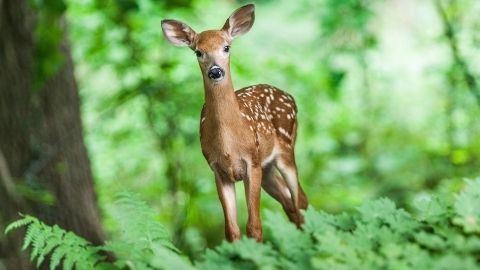Deer As Gas Molecules
 "In the 1960s, white-tailed deer were at the center of a controversy in the Adirondacks. Deer live throughout the Adirondacks and spend the summer months feeding on tree seedlings and other plants in the forest; they are especially fond sugar maple, yellow birch, and other commercially valuable species. Therein lay the "problem": competition between the deer, whose browsing inhibited regrowth of trees, and humans, whose livelihoods depended on harvesting and regrowing the timber.
"In the 1960s, white-tailed deer were at the center of a controversy in the Adirondacks. Deer live throughout the Adirondacks and spend the summer months feeding on tree seedlings and other plants in the forest; they are especially fond sugar maple, yellow birch, and other commercially valuable species. Therein lay the "problem": competition between the deer, whose browsing inhibited regrowth of trees, and humans, whose livelihoods depended on harvesting and regrowing the timber.
At that time, there was little debate over what needed to be done–get rid of the deer. The was also agreement over how many deer had to be killed to allow maple and birch seedlings to regrow: a 50% reduction in the population was hypothesized. Given the ruggedness of the terrain, however, disagreement arose over how to achieve that goal.
A young biologist at the Adirondack Ecological Center proposed a seemingly straightforward solution: to hunt intensively on a relatively small test area of 5,000 acres. His aim to reduce the area's estimated 300 deer to 150. Other biologists immediately questioned the idea. They maintained, reasonably, that much like gas molecules migrate from an area of dense concentration to a lower one, deer from the surrounding area would move in to fill any territorial vacuums. If the goal were tree regeneration on 5,000 acres, then deer would have to be removed from a much larger area to compensate for the "diffusion" effect. Since some of the biologists were betting men, the experiment became the subject of a wager, with the stakes set at a case of beer.
Did the deer behave as gas molecules?
The experiment was begun in the fall of 1967, and over the next four years, the population was reduced by the designated 50%. To the chagrin of the skeptics, deer from the surrounding areas did not behave like gas molecules. The wager lost and the beer dutifully handed over, the next question why didn't the deer fill the vacuum?"
The biologists concluded that deer outside the removal area were simply too strongly attached to their own home range to be drawn to the vacancies nearby. Deer do not behave like "gas molecules." Genetic analyses suggest that each summer range is shared by a group of related individuals, probably the daughters, granddaughters and great-granddaughters of a single female.
Deer from adjacent areas did not move into the area over a 10-year period."

